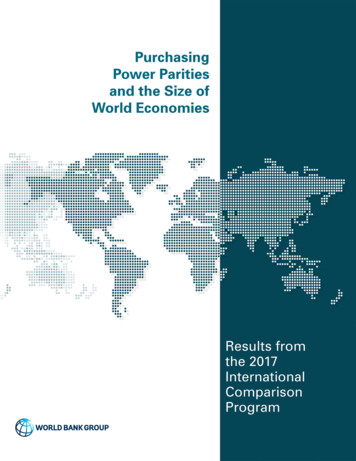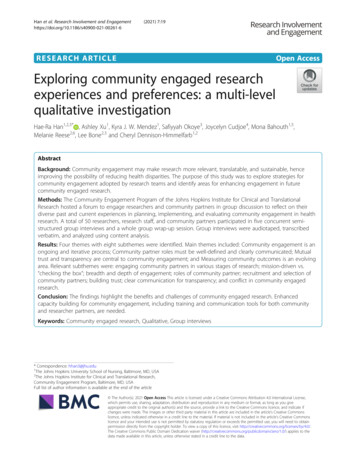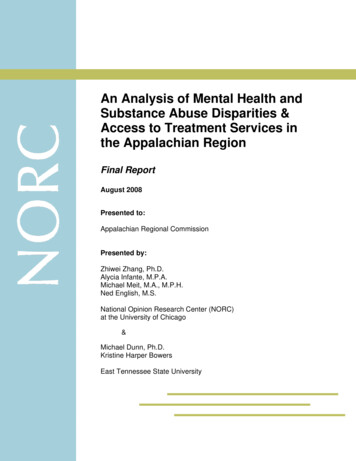
Transcription
Purchasing Power Parities and theSize of World Economies
PurchasingPower Paritiesand the Size ofWorld EconomiesResults from the 2017 InternationalComparison Program
2020 International Bank for Reconstruction and Development / The World Bank1818 H Street NW, Washington, DC 20433Telephone: 202-473-1000; Internet: www.worldbank.orgSome rights reserved1 2 3 4 23 22 21 20This work is a product of the staff of The World Bank with external contributions. The findings,interpretations, and conclusions expressed in this work do not necessarily reflect the views ofThe World Bank, its Board of Executive Directors, or the governments they represent. TheWorld Bank does not guarantee the accuracy of the data included in this work. The boundaries,colors, denominations, and other information shown on any map in this work do not implyany judgment on the part of The World Bank concerning the legal status of any territory or theendorsement or acceptance of such boundaries.Nothing herein shall constitute or be considered to be a limitation upon or waiver of theprivileges and immunities of The World Bank, all of which are specifically reserved.Rights and PermissionsThis work is available under the Creative Commons Attribution 3.0 IGO license (CC BY 3.0IGO) http://creativecommons.org/licenses/by/3.0/igo. Under the Creative Commons Attribution license, you are free to copy, distribute, transmit, and adapt this work, including for commercial purposes, under the following conditions:Attribution—Please cite the work as follows: World Bank. Purchasing Power Parities and theSize of World Economies: Results from the 2017 International Comparison Program. Washington, DC:World Bank. Doi: 10.1596/978-1-4648-1530-0. License: Creative Commons Attribution CC BY3.0 IGOTranslations—If you create a translation of this work, please add the following disclaimeralong with the attribution: This translation was not created by The World Bank and should not beconsidered an official World Bank translation. The World Bank shall not be liable for any content or errorin this translation.Adaptations—If you create an adaptation of this work, please add the following disclaimeralong with the attribution: This is an adaptation of an original work by The World Bank. Views andopinions expressed in the adaptation are the sole responsibility of the author or authors of the adaptationand are not endorsed by The World Bank.Third-party content—The World Bank does not necessarily own each component of thecontent contained within the work. The World Bank therefore does not warrant that the useof any third-party-owned individual component or part contained in the work will not infringeon the rights of those third parties. The risk of claims resulting from such infringement restssolely with you. If you wish to re-use a component of the work, it is your responsibility todetermine whether permission is needed for that re-use and to obtain permission from thecopyright owner. Examples of components can include, but are not limited to, tables, figures,or images.All queries on rights and licenses should be addressed to World Bank Publications, The WorldBank Group, 1818 H Street NW, Washington, DC 20433, USA; e-mail: pubrights@worldbank.org.ISBN (paper): 978-1-4648-1530-0ISBN (electronic): 978-1-4648-1531-7DOI: 10.1596/978-1-4648-1530-0Cover image and design: Jomo Tariku/World Bank GroupThe Library of Congress Control Number has been requested.
ContentsForeword. ixAcknowledgments . xiAbbreviations . xiiiChapter 1Overview of main findings .1Size of economies . 1GDP expenditure components . 2Per capita measures . 6Intercountry income inequality . 7Price levels . 9Variability across economies . 11Comparison of 2017 results with revised 2011 results . 14Chapter 2ICP 2017 results .17Tables of 2017 results . 17Survey framework . 19Chapter 3Purchasing power parities and real expenditures .63Concepts and definitions . 63Use and applications of PPPs and real expenditures . 67Chapter 4Governance and organization .73Governance of ICP 2017 . 73Regional and national organization . 74Chapter 5Methodology .77Conceptual framework . 78Expenditure data . 78Price data . 79PPP calculation and estimation . 81Chapter 6Looking forward.87Appendix A History of the International Comparison Program .89Appendix B The ICP’s governance framework .95The ICP’s governance structure . 95The roles and responsibilities of the ICP governance bodies . 95v
Appendix C ICP expenditure classification .1012017 ICP expenditure classification structure . 101Main aggregates. 102Deriving actual individual consumption . 102Facilitating the input price approach . 103Adjusting household expenditure to the national concept . 103Updates introduced for the 2017 ICP expenditure classification. 103Appendix D Reference PPPs used in ICP 2017 .115Appendix E Revised 2011 results and comparisons with originalICP 2011 results .119Appendix F Comparison of ICP 2017 results with WorldDevelopment Indicators data .167Appendix G ICP research agenda.179Appendix H ICP data access and archive policy.181Background. 181Data access objectives . 182Guiding principles . 182Procedures for archiving data . 183Procedures for accessing data . 184Appendix IICP revision policy .185Background. 185Triggers for revising ICP indicators . 185Guidelines for revising ICP indicators . 186Timing and communication of revisions . 187Appendix J Classification of the world’s economies .189Glossary .195References .207Boxes3.1 Using market exchange rates and PPPs to convert to a common currency. 643.2 Use of purchasing power parities . 704.1 ICP 2017 cycle: Participating economies, by region . 75Figures1.1 Share of global PPP-based and market exchange rate–based GDP and share ofglobal population, by region and income group, 2017 . 21.2 PPP-based GDP and share of global PPP-based GDP, by economy, 2017 . 31.3 Share of PPP-based global actual individual consumption for the sixeconomies with the largest shares, 2017 . 41.4 Share of global PPP-based expenditure on selected expenditure componentsof actual individual consumption, by region and income group, 2017 . 4viContents
1.5 Nominal expenditure on selected expenditure components of actual individualconsumption as a share of nominal GDP, by region and income group, 2017. 51.6 Share of PPP-based global consumption expenditure by government for thesix economies with the largest shares, 2017 . 51.7 Share of PPP-based global gross fixed capital formation for the six economieswith the largest shares, 2017 . 51.8 Index of PPP-based GDP per capita and share of global population,by economy, 2011 and 2017 . 61.9 PPP-based actual individual consumption per capita and share of globalpopulation, by economy, 2017 . 71.10 PPP-based GDP per capita and actual individual consumption per capitafor the 12 economies with the highest PPP-based GDP per capita, 2017 . 81.11 Index of PPP-based expenditure per capita for GDP and major expenditurecomponents, by region and income group, 2017 . 81.12 Lorenz curves for the distributions of 2017, revised 2011, and original 2011PPP-based GDP per capita . 91.13 Lorenz curves for the distributions of 2017, revised 2011, and original 2011PPP-based actual individual consumption per capita . 91.14 GDP price level index versus PPP-based GDP per capita (and PPP-based GDP),by economy, 2017 and 2011 . 101.15 Price level indexes for GDP and major expenditure components, by regionand income group, 2017 . 111.16 Price level indexes for GDP and 17 expenditure components, by region,2017 . 121.17 Coefficients of variation: Index of PPP-based expenditure per capita andprice level index for GDP and 17 expenditure components, by region, 2017 . 131.18 Share of global PPP-based and market exchange rate–based GDP and shareof global population, by region and income group, 2011 and 2017 . 141.19 Index of PPP-based expenditure per capita for GDP and major expenditurecomponents, by region and income group, 2011 and 2017 . 151.20 Price level indexes for GDP and major expenditure components, by regionand income group, 2011 and 2017. 164.1 ICP governance structure . 74B.1 ICP governance structure . 96Tables2.1 Gross domestic product (GDP): ICP 2017 results . 202.2 Actual individual consumption (AIC): ICP 2017 results . 262.3 Individual consumption expenditure by households: ICP 2017 results. 322.4 Consumption expenditure by government: ICP 2017 results . 382.5 Gross fixed capital formation (GFCF): ICP 2017 results. 44Contentsvii
2.6 Domestic absorption: ICP 2017 results . 502.7 Gross domestic product (GDP) and individual consumption expenditureby households for nonparticipating economies: ICP 2017 results . 562.8 ICP 2017 Individual consumption expenditure by households, surveyframework . 57C.1 Structure of the ICP expenditure classification, ICP 2017 . 102C.2 Expenditure classification, ICP 2017. 104D.1 ICP 2017 Reference PPPs . 116E.1 Gross domestic product (GDP): Revised ICP 2011 results . 120E.2 Actual individual consumption (AIC): Revised ICP 2011 results. 126E.3 Individual consumption expenditure by households: Revised ICP 2011results . 132E.4 Consumption expenditure by government: Revised ICP 2011 results . 138E.5 Gross fixed capital formation (GFCF): Revised ICP 2011 results . 144E.6 Domestic absorption: Revised ICP 2011 results . 150E.7 Gross domestic product (GDP) and individual consumption expenditure fornonparticipating economies: Revised ICP 2011 results . 156E.8 Gross domestic product: Comparison of revised ICP 2011 results withoriginal ICP 2011 results . 157E.9 Individual consumption expenditure by households: Comparison of revisedICP 2011 results with original ICP 2011 results . 162F.1 Gross domestic product (GDP): Comparison of ICP 2017 results with datain World Development Indicators . 168F.2 Individual consumption expenditure by households: Comparison ofICP 2017 results with data in World Development Indicators . 173J.1 Economies in East Asia and Pacific, classified by ICP 2017 administrativeregion and World Bank fiscal year 2020 income group . 190J.2 Economies in Europe and Central Asia, classified by ICP 2017administrative region and World Bank fiscal year 2020 income group . 191J.3 Economies in Latin America and the Caribbean, classified by ICP 2017administrative region and World Bank fiscal year 2020 income group . 192J.4 Economies in Middle East and North Africa, classified by ICP 2017administrative region and World Bank fiscal year 2020 income group . 193J.5 Economies in North America, classified by ICP 2017 administrative regionand World Bank fiscal year 2020 income group . 193J.6 Economies in South Asia, classified by ICP 2017 administrative region andWorld Bank fiscal year 2020 income group . 193J.7 Economies in Sub-Saharan Africa, classified by ICP 2017 administrativeregion and World Bank fiscal year 2020 income group . 194viiiContents
ForewordAs this report goes to publication, our planet is inthe midst of the COVID-19 pandemic, with countries facing costs to both lives and livelihoods.This report presents the latest results from theInternational Comparison Program’s (ICP) 2017cycle and provides a view of the global economyprior to the emergence of this pandemic. The ICP2017 results will serve as a crucial benchmark ofthe pre-COVID-19 size of the world economiesfrom which to measure the economic impact onvarious countries across the globe.In 2017, the United States and China werethe two largest economies in the world andtogether accounted for a third of the globaleconomy. India, the third largest economy,accounted for around 7 percent of global grossdomestic product (GDP). The global economy,when measured using purchasing power parities(PPPs) rather than market exchange rates, is splitmore or less equally between high-income andmiddle-income economies, with low-incomeeconomies contributing just 1 percent of globalGDP. The United States remained the economywith the highest level of per capita consumption,at nearly US 45,000 in PPP terms, more thanfour times the world average. Cross-countryinequality persisted, with around three-quartersof the world’s population living in economieswhere the mean per capita income and consumption were below their respective globalaverages of US 16,596 and US 10,858.The ICP is a global statistical initiative to collect comparative price and expenditure dataand estimate PPPs for the world’s economies.PPPs are used in monitoring progress towardthe United Nations Sustainable DevelopmentGoals—in particular, the goals focusing onpoverty and inequality, agriculture, health,education, energy and emissions, labor, andresearch and development. PPPs are also usedin other international indicators of economies’socioeconomic development, such as the WorldBank’s twin goals of ending extreme povertyand promoting shared prosperity by 2030, theUnited Nations’ human development index, theWorld Economic Forum’s global competitiveness index, the Gates Foundation’s GoalkeepersReport, and the International Labour Organization’s Global Wage Report, to name a few.The International Bank for Reconstruction andDevelopment and the International MonetaryFund both rely on the GDP in PPP terms ofeconomies to determine their shareholding anddrawing rights.The ICP is globally one of the largest data collection exercises undertaken—176 economiesparticipated in its 2017 cycle. At the same time,it is one of the most enduring—the programcelebrated its 50th anniversary in 2018, havinggrown from a modest research project spearheaded by the United Nations Statistical Division and the International Comparisons Unit ofthe University of Pennsylvania, supported byfinancial contributions from the Ford Foundation and the World Bank.Today the successful execution of the ICP isreliant on the close collaboration of nationalstatistical offices, regional agencies, and international organizations. That partnership, togetherwith a robust governance structure, an extensive capacity-building program, and an ambitious research agenda, ensures that the programand its results remain impactful and relevant toits constituents and users and reflect our everchanging world and its dynamic economies.Looking ahead, we anticipate that the ICPwill evolve to meet both our users’ demandsand the challenges of the new decade byix
reflecting the rapid change in buying habits taking place across the world, not only in what weconsume today but also in the outlets and platforms through which we purchase these goodsand services, and by complementing traditionalsurveys with new data sources such as scannerdata and web scraping. We also expect participation in the program to increase so that we leaveno country behind. This is especially true forcountries that are fragile and those that areaffected by conflict and violence. We havestrived to ensure that these countries partook inICP 2017 capacity-building activities, and wehope that they will join subsequent ICP cycles.We would like to thank the participatingeconomies that conducted the extensive surveysand data collections that underlie the PPPs. Wethank as well our partners who contributed tothe success of ICP 2017—the African Development Bank, the Asian Development Bank, theInternational Monetary Fund, the InterstateStatistical Committee of the Commonwealth ofIndependent States, the Organisation for Economic Co-operation and Development, the Statistical Office of the European Union, the UnitedKingdom’s Department for International Development, the United Nations Economic Commission for Latin America and the Caribbean, andthe United Nations Economic and Social Commission for Western Asia. Although the responsibility for oversight rested with the ICPGoverning Board, the program would not havebeen a success without the invaluable theoretical, conceptual, and methodological advice ofthe ICP Technical Advisory Group of renownedexperts, chaired by Nobel Laureate Sir AngusDeaton.The ICP 2017 results are based on the mostcomprehensive price and national accountsexpenditure data available, using the best methods that have been developed to date. We trustthat users of the ICP 2017 results will find thisreport useful and that those results will providethem with a base of crucial information forresearch in comparative analysis and policymaking.Over time, the ICP has evolved to become aleading “global public good” exercise throughthe efforts of its worldwide partnership. We aretwo years into the ICP’s second half century, onein which the world is growing more data savvyand more data hungry, and we look forward toPPPs and ICP data entering common parlanceand throwing a much-needed spotlight on theeconomies, big and small, that together make upour global economy.Mari Elka PangestuManaging Director for Development Policy and PartnershipsThe World BankxForeword
AcknowledgmentsThe International Comparison Program (ICP) isone of the world’s largest statistical exercises.The 2017 cycle involved a partnership of 176economies and global, regional, and subregional agencies, working together within theprogram’s governance structure to produce theresults presented in this report. These achievements were made possible by the financial support of donors who contributed to funding thiscycle. Special thanks go to the InternationalMonetary Fund (IMF) and the United Kingdom’s Department for International Development (UK DFID), which contributed to a globalMulti-Donor Trust Fund, to the regional development banks and implementing agencies thatcontributed to funding regional programs, andto the World Bank, which contributed to funding the global program.The program is managed by the ICP GlobalOffice, located at the World Bank DevelopmentData Group (DECDG), under the leadership ofNada Hamadeh, Program Manager, and theoversight of Haishan Fu, DECDG Director. Asthe strategic and policy-making body, the ICPGoverning Board provides leadership andensures strict adherence to the program’s objectives and strategic lines. The board was cochaired by Statistics Austria and India’s Ministryof Statistics and Programme Implementation.Thanks are extended to the institutions represented on the board: the African DevelopmentBank (AfDB), the Asian Development Bank(ADB), the Brazilian Institute of Geography andStatistics, the National Statistical Committee ofthe Republic of Belarus, China’s National Bureauof Statistics, the Interstate Statistical Committeeof the Commonwealth of Independent States(CIS-STAT), the Statistics Department of theEuropean Union (Eurostat), the StatisticsDepartment of the IMF, the Fiji Bureau of Statistics, the Organisation for Economic Co-operation and Development (OECD), the Kingdom ofSaudi Arabia’s General Authority for Statistics,the National Agency for Statistics and Demography of Senegal, Statistics South Africa, Suriname’s General Bureau of Statistics, UK DFID, theUS Bureau of Labor Statistics, the United NationsEconomic Commission for Latin America andthe Caribbean (UN-ECLAC), the United NationsEconomic and Social Commission for WesternAsia (UN-ESCWA), the United Nations StatisticsDivision (UNSD), and the World Bank’s DECDG.Thanks are also extended to previous co-chairsof the Governing Board Konrad Pesendorfer,former Director General, Statistics Austria, andT. C. A. Anant, former Chief Statistician of Indiaand Secretary, Ministry of Statistics and Programme Implementation.The ICP Technical Advisory Group (TAG)deserves special acknowledgment. Under thechairmanship of Nobel Laureate Sir Angus Deaton, technical issues linked to the conceptualintegrity and methodological soundness of theprogram were addressed by the group comprising W. Erwin Diewert, Robert C. Feenstra, AlanHeston, Walter Radermacher, D. Prasada Rao,Pronab Sen, Paul Shreyer, and Xianchun Xu.Over the cycle, the TAG appointed task forcesand task teams to undertake specific researchtopics under its research agenda. Task forces andteams comprised the following experts: AlanHeston, Bettina Aten, Luigi Biggeri, W. ErwinDiewert, Levan Gogoberishvili, Brian Graf, Robert Hill, Robert Inklaar, Massimiliano Iommi,Kaushal Joshi, Patrick Kelly, Francette Koechlin,Paul Konijn, Dilip Kumar Sinha, VasilyKuznetsov, Gregory Max Henri Legoff, MichelMouyelo-Katoula, Bala Bhaskar Naidu Kalimili,xi
xiiLiu Nan, Niall O’Hanlon, D. Prasada Rao, DavidRoberts, Sergey Sergeev, Majed Skaini, MichaelSmedes, and staff of the Global Office.The results of ICP 2017 were calculated bythe group of experts forming the computationtask team: Yuri Dikhanov, Alan Heston, RobertHill, Robert Inklaar, Francette Koechlin, PaulKonijn, D. Prasada Rao, Miriam Steurer, andSergey Sergeev. Bettina Aten and Eric Figueroaadvised on the process for producing the results.Our achievement was made possible by therelentless work of the regional coordinatorswith their supporting teams: Ben Paul Mungyereza and Gregoire Mboya De Loubassou (AfDB)for Africa; Kaushal Joshi with the support ofCriselda de Dios and Stefan Schipper (ADB) forAsia and the Pacific; Andrey Kosarev and Valerica Accibas (CIS-STAT) for the Commonwealthof Independent States; Rolando Ocampo,Giovanni Savio, Bruno Lana, María Paz Collinao, and Federico Dorin (UN-ECLAC) withPhilomen Harrison (CARICOM) for Latin America and the Caribbean; and Majed Skaini withthe support of Sadim Sbeiti (UN-ESCWA) forWestern Asia. The program also relied on closecooperation with Francette Koechlin and SophieBournot (OECD) and Paul Konijn and MarjancaGasic (Eurostat), who led the Eurostat-OECDPPP Programme.Although the Global Office and the regionalcoordinators play a crucial role in implementingthe ICP, the cornerstone of the program consistsof the national implementing agencies, whichare responsible for the bulk of ICP activities, fromthe collection of price data to the compilation ofnational accounts expenditure data. The 2017participating economies demonstrated completecommitment and dedication to the ICP. We trulyowe them the utmost gratitude and appreciationfor the amazing job they did in carrying outrigorous ICP activities over the last few years.The Global Office team responsible for theday-to-day work comprised Hanan Abushanab,Shriya Chauhan, Rui Costa, Yuri Dikhanov,Nancy Kebe, Maurice Nsabimana, ChristelleSigno Kouame, Elizabeth Purdie, Marko OlaviRissanen, Inyoung Song, William Vigil Oliver,Mizuki Yamanaka, and Zhe Zhao. Several colleagues from other DECDG units provided valuable support to the Global Office
Attribution—Please cite the work as follows: World Bank. Purchasing Power Parities and the Size of World Economies: Results from the 2017 International Comparison Program. Washington, DC: World Bank. Doi: 10.1596/978-1-4648-1530-. . World Bank fiscal year 2020 income group . 193 J.7 Economies in Sub-Saharan Africa, classified by ICP .










